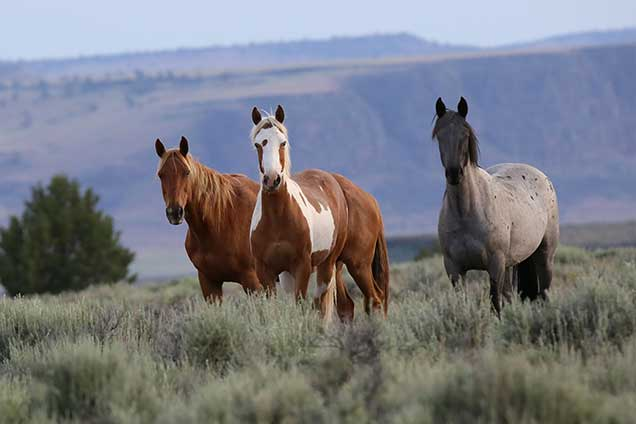Picture the American West.
What do you see? Does a herd of wild mustangs galloping across a sagebrush expanse come to mind? For many, romantic images of the western landscape celebrated in popular culture symbolize American ideals of rugged individualism and freedom. Although first introduced to North America by European colonists, wild horses came to represent those important American themes in our images of the West. Now, the iconic symbols pose a threat to western ecosystems.
Despite their cultural appeal throughout the 20th century, the population of horses on the western range dwindled due to the harvesting activities of “mustangers.” Lawmakers responded to this assault on the American identity by unanimously enacting the Wild Free-Roaming Horses and Burros Act in 1971. The Act aimed to protect these “living symbols of the historic and pioneer spirit of the West” from “capture, branding, harassment, or death,” and directed federal agencies to manage the animals in certain regions of public lands.
It worked. The Bureau of Land Management (BLM, the primary agency charged with administering the Act) estimates that there were approximately 25,000 wild horses and burros on public lands in 1971. By 2018, that number exceeds 82,000.

Courtesy of the Bureau of Land Management, U.S. Department of Interior
But the story does not end here. Federal agencies charged with implementing the Act have another responsibility: to manage the animals “in a manner that is designed to achieve and maintain a thriving natural ecological balance on the public lands.” In pursuit of this goal, BLM is required to remove excess animals when it determines that there is an overpopulation. BLM estimates that the range can support approximately 27,000 horses and burros while maintaining a healthy ecological balance with other wildlife and livestock. The current population exceeds this threshold by approximately 300 percent. Experts predict that natural forces such as predation will not control this excess; in fact, unchecked wild horse and burro herds double in size every four years.
BLM now faces a significant management challenge. Overpopulation can lead to overgrazing and resulting starvation and thirst among the horses, burros, and other wildlife. It can also help spread invasive weeds and increase conflicts with private property and roads. To respond to the overpopulation, BLM focuses on periodically gathering and permanently removing animals from the range. This method has limited effectiveness: while approximately 4,099 animals were adopted in 2017, nearly 46,000 are currently held in off-range corrals and pastures. BLM spends approximately $49 million per year (two-thirds of the wild horse and burro program budget) maintaining care in these facilities.
BLM is eager to find alternative (and more economically sustainable) management approaches and asked the National Academy of Sciences to review its management program and make recommendations. The National Academy recommended contraception and fertility control as the most promising method of population control. BLM currently uses fertility control techniques that limit fertility for two years. BLM has demonstrated interest in studying and using these more broadly, with emphasis on longer-term effectiveness. Fertility control measures would limit the reproduction capacity of the wild herds, therefore reducing the population on the range without requiring the agency to support the animals in holding facilities.
Further contributing to the management challenge, vocal advocates from all sides criticize the agency’s approach. Some parties want fewer horses and burros on the range to reduce grazing competition for livestock and wildlife and initiate lawsuits against BLM forcing the agency to remove animals. On the other hand, horse advocates attack when BLM does take management actions. Horse advocates want to keep more horses on larger areas of public land, oppose subjecting animals to the stress of removal, and criticize fertility control and sterilization procedures as dangerous and scientifically unwarranted. The cultural love for horses that originally instigated protections now makes any management effort extremely controversial.
In many ways, we are fortunate to discuss an excessively successful recovery. However, BLM now finds itself corralled in a management puzzle by competing forces of ecology, law, and constituent advocates. Fertility control measures may provide a promising solution, but this modern western drama is far from over. For now, BLM continues its quest for an effective and economical management strategy that will maintain genetically viable, healthy populations while preserving the ecosystem.
Editor’s note: This post originally appeared on the Georgetown Environmental Law Review Online blog on October 3, 2018, at https://www.law.georgetown.edu/environmental-law-review/blog/trotting-towards-trouble-the-state-of-the-bureau-of-land-managements-wild-horse-and-burro-program/ and is reprinted with permission.
